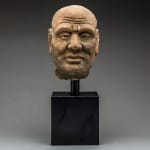Ming Dynasty Lohan Stone Head, 1368 CE - 1644 CE
Stone
21.6 x 15.2 cm
8 1/2 x 6 in
8 1/2 x 6 in
AM.0336
Further images
The Ming Dynasty was the ruling dynasty of China from 1368 to 1644, following the collapse of the Mongol-led Yuan Dynasty. The Ming was the last dynasty in China ruled...
The Ming Dynasty was the ruling dynasty of China from 1368 to 1644, following the collapse of the Mongol-led Yuan Dynasty. The Ming was the last dynasty in China ruled by ethnic Hans, before falling to the rebellion led in part by Li Zicheng and soon after replaced by the Manchu-led Qing Dynasty. The last of the outstanding dynasties, the Ming was vibrant during its first half but racked with internal discord during its second. Scores of workers constructed the renowned Forbidden City, an imperial palace of staggering proportions and opulence. Ming leaders revived a sense of cultural identity and respect for traditional artifacts and craftsmanship.
Even today, when entering the main hall of a Buddhist temple in China, one will discover two rows of sculpted figures, traditionally numbering eighteen in total. These figures are known as the Eighteen Lohan. Lohan is the Chinese term, derived from the Sanskrit word Arhan, for a disciple or follower of Buddha who has reached a state of enlightenment. The Lohan had been a popular subject in Chinese art at least since the cultural flourishing of the Tang Dynasty. Traditionally, they are always produced in sets of sixteen or eighteen. The numerical difference is a result of discrepancies in Buddhist texts. By the Song Dynasty, artists began to depict each Lohan with individualized facial features. Having achieved enlightenment, Lohans were free from all earthly desires and no longer subject to the cycle of rebirth. In this example serenity and wisdom are conveyed through the creased forehead, absent gaze and smiling mouth. The area around the eyes and brow is particularly well-modelled and overall the head is in excellent condition.
Even today, when entering the main hall of a Buddhist temple in China, one will discover two rows of sculpted figures, traditionally numbering eighteen in total. These figures are known as the Eighteen Lohan. Lohan is the Chinese term, derived from the Sanskrit word Arhan, for a disciple or follower of Buddha who has reached a state of enlightenment. The Lohan had been a popular subject in Chinese art at least since the cultural flourishing of the Tang Dynasty. Traditionally, they are always produced in sets of sixteen or eighteen. The numerical difference is a result of discrepancies in Buddhist texts. By the Song Dynasty, artists began to depict each Lohan with individualized facial features. Having achieved enlightenment, Lohans were free from all earthly desires and no longer subject to the cycle of rebirth. In this example serenity and wisdom are conveyed through the creased forehead, absent gaze and smiling mouth. The area around the eyes and brow is particularly well-modelled and overall the head is in excellent condition.





